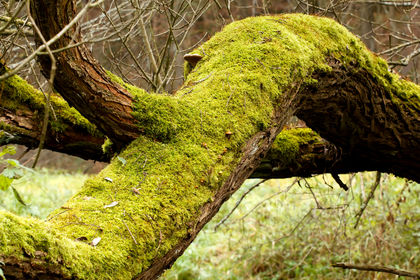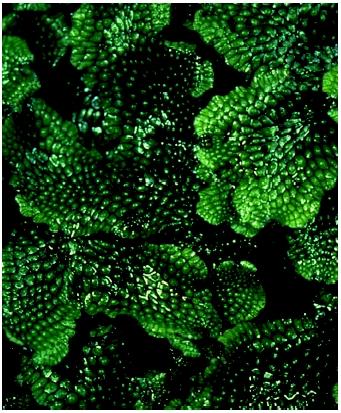Bryophytes

Bryophytes are seedless plants without specialized water-conducting tissues. Bryophytes include mosses (phylum Bryophyta), liverworts (phylum Marchantiophyta Hepatophyta), and hornworts (phylum Anthocerophyta). They are plants that virtually everyone has seen, but many have ignored. The most commonly encountered group is the green mosses that cover rotting logs, anchor to the bark of trees, and grow in the spray of waterfalls, along streams and in bogs. Even though mosses often thrive in wet habitats, many mosses and some liverworts can survive in relatively dry environments such as sandy soils and exposed rock outcrops.
The liverworts can take leafy forms, which are very similar superficially to mosses, but differ in the details of leaf size and arrangement. Other liverwort genera are characterized by a thallus made up of relatively small, flattened, ribbonlike segments of photosynthetic tissue, which have the general appearance of short, branched pieces of rich dark green egg noodles or linguini.
The leafy liverworts and the mosses differ in the appearance of their spore-forming structures. The mosses have thin stalks called seta extending from the ends of leafy branches. Seta bear capsules, which produce spores. The leafy and thalloid liverworts have very small, balloon-shaped spore-producing stages that remain virtually hidden within, and totally dependent upon, the photosynthetic plant tissues. The third major group of bryophytes is the hornworts. They received this common name because their spore producing structures, called sporangia, are generally long, slender, hornlike, and without capsules. More than eighteen thousand different bryophyte species have been identified throughout the world, and there are perhaps ten thousand species of moss, approximately eight thousand liverwort species, and only a little more than one hundred species of hornworts.
Characteristics of Bryophytes
There are several characteristic features of bryophytes. First, the green tissue that makes up most of the plant body is not vascularized; it does not have xylem and phloem cells. This absence of specialized tissues for transporting water and dissolved food throughout the organism limits terrestrial forms to being very short plants, since the only way to move substances through the plant body is by osmosis and diffusion from surface moisture.
Second, bryophytes do not have roots, but have rhizoids, which are relatively simple, sometimes multicellular filaments of thin-walled cells that extend from the photosynthetic tissue into the soil or other substrate . They anchor the plant somewhat and in some cases facilitate water and nutrient uptake.

Sexual Reproduction
The third characteristic of bryophytes is something that one could not guess by just looking at the conspicuous green tissue. Unlike other plants (and indeed most other multicellular organisms), the conspicuous portion of bryophytes is composed of haploid cells, containing only one set of chromosomes .
Sexual reproduction in animals involves the union of an egg and a sperm to form a fertilized egg (zygote). This diploid (2n) cell divides mitotically to produce an embryo, and ultimately a mature adult organism. These adults have specialized cells, which divide meiotically to produce haploid (n) sperm or eggs depending on the sex of the individual. In the plant kingdom, this cycle of fertilization and meiosis involves an alternation of generations between the haploid gamete -producing stage (gametophyte) and the diploid organism (sporophyte).
Vascular plants, including flowering plants, conifers, and many, such as ferns, that do not produce seeds, have life cycles with the diploid sporophyte being the predominant generation. In the bryophytes, it is the haploid gametophyte that produces the leaves and thali and therefore predominates. This change from predominant gametophyte to sporophyte was a major evolutionary advancement, which along with the development of vascular tissue facilitated the ultimate success of plants in a diversity of terrestrial habitats.
In order to accomplish sexual reproduction, bryophyte gametophytes produce eggs (n) in the archegonium, a vase-shaped structure that is the female reproductive organ. The sperm (n) are produced in antheridia, which may occur on the same gametophyte, but are often located on separate male plants. Water is generally required for them to swim to the eggs for fertilization. The resulting zygote (2n) develops into the sporophyte (2n). The sporophytes remain attached to and dependent on the female gametophyte. These parasitic sporophytes produce spores (n) by meiosis that then divide mitotically to produce the obvious multicellular gametophyte.
SEE ALSO Alternation of Generations ; Angiosperms ; Plant ; Pteridophytes ; Seedless Vascular Plants ; Translocation ; Water Movement in Plants
Dean Cocking
Bibliography
Conard, Henry Shoemaker, et al. How to Know the Mosses and Liverworts, 2nd ed. New York: McGraw-Hill, 1980.
Malcolm, Bill, and Nancy Malcolm. Mosses and Bryophytes: An Illustrated Glossary. Portland, OR: Timber Press/Micro-Optics Press, 2000.
Shaw, A. Jonathan, and Bernard Goffinet, eds. Bryophyte Biology. New York: Cambridge University Press, 2000.
WANT MORE ON BRYOPHYTES AND OTHER PLANTS STUDIED IN THE FIELD OF BOTANY